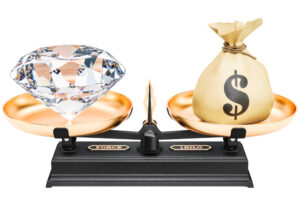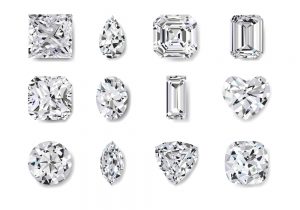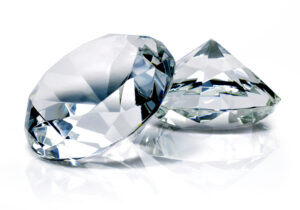THE FOUR Cs

At Diamond Works Jewelry, we know that quality and value for the money are more important now than they have ever been when it comes to your most important purchases. Other than a home and an automobile, a diamond is one of the largest purchases most people will ever make. As with any other major purchase, it’s important to understand exactly what you are purchasing, and what makes diamonds that may appear similar have vastly different values.
The Gemological Institute of America (GIA) has established a system for grading diamonds, commonly known as the Four Cs. This system, when used accurately and completely, is the best way to assure the quality and value of a diamond. It is worth noting that this system can only be accurately applied when the diamond is loose. This is the reason for the McGivern Diamonds policy of only selling loose diamonds.
It is possible to send a diamond in to the GIA and request a grading. A diamond graded in this way is referred to as a GIA certified diamond. Diamond Works Jewelry maintains the relationships that allow us to find the best diamonds available and sell them for the best price. The simple fact is that not all jewelers can do this, but they still must make it appear as if they can. Thus, many other certificates exist that are far from accurate.
It can appear that you are getting the same grade of diamond for much less money. The real question is this: a certificate may state that the diamond is a certain grade, but will the GIA agree? Most likely they will not, so these other certificates can often be disregarded. Whether you end up buying from Diamond Works Jewelry or not, stick with a GIA certified stone, as they are the industry standard.
The GIA is a non-profit organization that has no interest where you purchase your stone. Unfortunately, too many other so called “independent” labs are operated for profit, with the jeweler’s best interests in mind rather than the consumer’s. Diamond Works Jewelry recommends only GIA certified diamonds. Feel free to visit the Diamond Works Jewelry shop to have your diamond assessed!
 Carat is actually a measurement of weight, NOT size. One carat is divided into 100 points. Two diamonds of equal quality can have vastly different values depending on their cut, color, and clarity.
Carat is actually a measurement of weight, NOT size. One carat is divided into 100 points. Two diamonds of equal quality can have vastly different values depending on their cut, color, and clarity.
Carat weight is the easiest of the Four Cs to determine. However, the diamond MUST be loose. Too many jewelers approximate the carat weight. For instance, when you buy a ½ carat diamond, which you assume to be 50 points, you may actually be getting less than that. Many stores sell stones with as few as 45 points and represent these as “approximately” a ½ carat.
There is nothing wrong with buying a “light” 1/2 carat, however the cost is significantly less. You should know what you are buying and pay accordingly. At Diamond Works Jewelry, a ½ carat stone is exactly that – half of a carat, or 50 points. Diamond Works Jewelry will always portray every stone as exactly what it really is.
 By cut, we are referring to two things, the first being the shape of the diamond. By this we mean round, marquise, pear, oval, princess, emerald, heart or trillion. When a gemologist talks about cut, what is really being referred to is the quality of the proportions. The fact is that many diamonds today are not cut as well as they could be. Many cutters choose to sacrifice some of the diamond’s beauty to achieve a stone that is a larger carat weight.
By cut, we are referring to two things, the first being the shape of the diamond. By this we mean round, marquise, pear, oval, princess, emerald, heart or trillion. When a gemologist talks about cut, what is really being referred to is the quality of the proportions. The fact is that many diamonds today are not cut as well as they could be. Many cutters choose to sacrifice some of the diamond’s beauty to achieve a stone that is a larger carat weight.
Cut, more than any other quality aspect, gives the diamond its sparkle. A diamond gets its brilliance and scintillation by cutting and polishing the diamond facets to allow the maximum amount of light to be reflected and dispersed back through the top of the stone.
When all the angles are correct, the light that enters is dispersed back through the diamond’s top facets. When a stone is cut too shallowly or too deeply, that light that enters through the top is allowed to escape through the bottom, which does not allow the maximum beauty of the diamond to be realized.
The reason these poorly cut diamonds are sold in stores is simply cost. The wholesale cost of these diamonds is significantly cheaper than that of a well-proportioned diamond.
Remember, just because two diamonds have the same weight, that does not mean that they are the same size. At Diamond Works Jewelry, we sell stones that are cut properly so their true beauty shines through. Visit Diamond Works Jewelry for the most beautiful stones!

Diamonds come naturally in almost every color of the rainbow. However, most people are concerned with diamonds in the white range. Along with cut, this “C” is also very important in determining the overall beauty of the diamond. Color starts with the letter D, being the whitest, or best, and goes down to the letter Z, which looks yellowish. It is the lack of color, or whiteness in a diamond that allows the light to pass effortlessly through the stone and disperse that beauty back to the observer.
Color is not so much white versus yellow, as the chart tends to indicate, it is more accurately described as light versus dark. A white diamond will look clean, crisp, and brilliant, with a lot of pizazz. A yellow diamond will not really look yellow, as it will look dark and dirty, without anywhere near the same brilliance. You do not need to be a gemologist to see these differences, as they are clearly visible. Diamond Works Jewelry recommends for you to look closely at the brilliance and shine of the stone you’re considering.

Clarity refers to how many flaws, or inclusions, are in the diamond. In most cases, clarity has very little to do with the beauty of the diamonds. Rather, it effects how the diamond looks under the microscope. To determine a diamond’s clarity grade, it must be examined loose, under 10x magnification by a gemologist.
Generally, if a diamond is SI-1 or above, it is flawless to the naked eye (VS-2 for emerald, princess, and radiant cuts). If there is even a tiny inclusion visible to the unaided eye, the stone is usually graded an SI-2 or I-1. It is extremely important to view the diamond loose for clarity grading, as it is very easy to set an I-1 diamond, and by concealing flaws in setting, make the diamond appear to be much better than it really is. There is nothing wrong with this, as long as this is represented accurately, and you pay accordingly.
As you can see from this essay, the quality of your diamond is affected by many different factors – some of which can be manipulated by the jeweler so that you ended paying more for a lower-quality gem. At Diamond Works Jewelry, we don’t engage in those types of tricks. Diamond Works Jewelry will always represent every piece we sell in an accurate and honest way.
